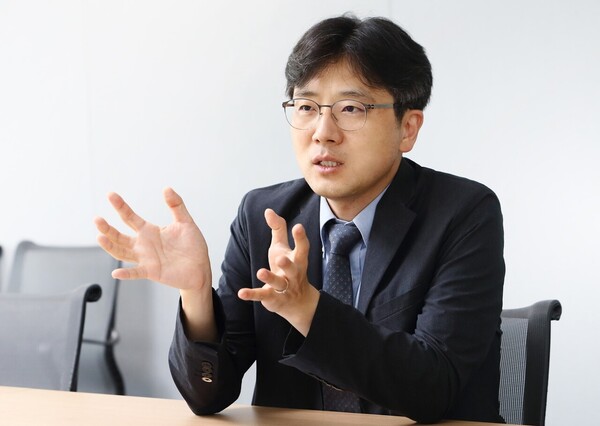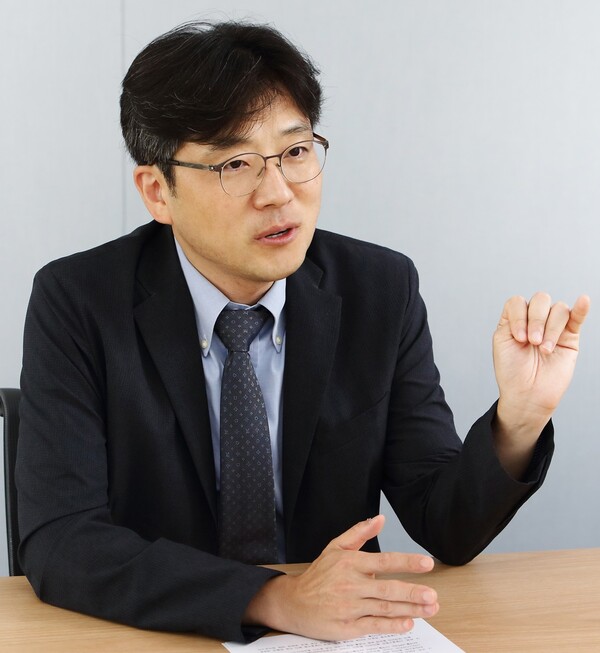Multiple myeloma is the second most common hematologic malignancy, and most patients undergo a relapse, with about 15 percent experiencing three or more relapses or treatment failures.
Patients who have experienced repeated relapses with conventional therapies, such as proteasome inhibitors, immunomodulators, and anti-CD38 antibodies, have an abysmal prognosis, with a life expectancy of less than half a year and few treatment options.
Recently, immunotherapies, such as CAR-T cell therapy and bispecific antibody therapy, have been introduced to treat relapsed or refractory multiple myeloma.
Among them, Janssen's Tecvayli (teglistamab), the first bispecific antibody introduced in Korea, recently received approval from the Ministry of Food and Drug Safety to treat patients with relapsed or refractory multiple myeloma who have received three or more treatments, including proteasome inhibitors, immunosuppressive drugs, and anti-CD38 monoclonal antibodies.
Korea Biomedical Review met with Dr. Jung Sung-hun, professor of hematology at Chonnam National University Hwasun Hospital, to learn more about the treatment environment for multiple myeloma patients in Korea, the clinical value of Tecvayli as a new treatment option, and the prospects for its use in clinical practice here.

Question: What characteristics of multiple myeloma was Tecvayli designed to target?
Answer: Bispecific antibodies' therapeutic principle is similar to CAR-T cell therapy. The most important immune cells that ultimately kill cancer are T-cells, so many attempts have focused on activating T-cells to kill cancer.
CAR-T therapy is based on the principle that by taking T cells from the body, changing the gene called “CAR,” amplifying it, and injecting it back into the body, the T cells are activated and can kill multiple myeloma cells. Bispecific antibodies, on the other hand, are like monoclonal antibodies that have already been developed but have an additional site they can recognize. One recognizes multiple myeloma cancer cells, and the other recognizes T-cells. Once the bispecific antibody enters the body and recognizes the multiple myeloma cells, it grabs the surrounding T-cells and activates them again, killing the multiple myeloma cells.
In recent years, identifying BCMA (B-cell maturation antigen) as a valuable target in multiple myeloma has made it possible to develop bispecific antibody therapies, such as Tecvayli. If the target is expressed not only on multiple myeloma cancer cells but also on normal cells, it can cause damage to normal cells and increase side effects. BCMA is expressed on normal B cells but mainly on multiple myeloma cells, so many bispecific antibodies or CAR-T therapies currently target it.
The main advantage of bispecific antibodies over CAR-T therapies is that they are commercially available and can be administered when needed. With CAR-T therapies, patients must wait about a month-and-a-half to two months before they can receive the treatment because there is a process of harvesting the patient's T-cells, sending them to a factory, making them, and getting them back. While bispecific antibodies have shown slightly lower response rates in clinical studies compared to CAR-T therapies, they can be administered to patients at any time.
Q: Tecvayli has won approval to treat patients with relapsed or refractory multiple myeloma at least three times or more. However, in Korea, the use of immune-mediated inflammatory disease (IMID) or immunomodulatory drugs, proteasome inhibitors (PIs), and monoclonal antibodies used in the first line are not freely available due to insurance coverage issues. We are curious about Tecvalyli's treatment strategy, considering these points.
A: In Korea, first- to fourth-line treatments are determined to some extent by insurance coverage, so Tecvayli is likely to be used as a fifth-line treatment for patients who do not respond to monotherapy with daratumumab (Darzalex), a monoclonal antibody used primarily as a fourth-line treatment.
In Korea, the VRd (vortezomib + renalidomide + dexamethasone) combination is currently covered for the first-line treatment of relapsed/refractory patients, and eight out of 10 patients receive this first-line therapy. The second-line regimen is most often Kd (capecitabine + dexamethasone), as there is a risk of reimbursement cuts for higher-priced drugs not covered by insurance. In this way, the third line is mostly Pd (pomalidomide + dexamethasone) or PCd (pomalidomide + dexamethasone + cyclophosphamide), and the fourth line is daratumumab monotherapy.
Of course, some patients who received daratumumab off-label before line 4, such as those treated with DVTd (daratumumab + bortezomib + thalidomide + dexamethasone), DRd (daratumumab + renalidomide + dexamethasone), or DVMP (daratumumab + vortezomib + melphalan + prednisolone), may be able to access Tecvayli a little sooner.
Q: What is the existing unmet medical need of the patients targeted by Tecvayli?
A: International reports have shown that patients refractory to the usual triad of immunomodulators, proteasome inhibitors, and monoclonal antibodies typically have a median survival time of less than 10 months and a median effectiveness of less than four months on any treatment. These patients end up receiving treatments that they have never received before, such as doxorubicin, vincristine, and VAD (vincristine + doxorubicin + dexamethasone) regimens, which are less effective and more toxic, or treatments highly associated with plasmacytoma and highly suppress bone marrow function. As a result, when a patient loses response on the fourth line of treatment, it is almost impossible for them to survive.
Q: How well has Tecvayli performed in those patients?
A: The trial that showed it was the MajesTEC-1 study. It included patients who had received, on average, five prior therapies, so it included patients who were not as well-tolerated and consequently had a progression-free survival of four to five months. Long-term data from the MajesTEC-1 study showed a median progression-free survival of approximately 11.3 months in the Tecvayli arm. Patients who responded maintained their responses for nearly 22 months, making it a drug beyond conventional therapy.
The story is similar in real life. In Korea, about 50 patients were treated with Tecvalyli free of charge in a compassionate support program, not a clinical study. At each institution, the response to treatment was speedy, usually within one month, and the immunoglobulin M protein dropped rapidly. In fact, in our hospital, a patient had no more treatment and could not move around on his own. Still, he was lucky enough to receive Tecvalyli treatment at the right time through the support program, and he was discharged from the hospital about three to four weeks after receiving Tecvayli treatment. He has since been attending outpatient clinics for many months now. This patient could have died within two weeks, but he responded very well.
Of course, not all patients will respond, but the advent of Tecvayli has given patients with multiple myeloma for whom there was no longer a cure, a drug that goes beyond the concept of simply living another month or two. Patients not even looking beyond six months have been able to live up to two years longer, and that doesn't just mean two years longer. With new drugs soon, these patients can look further into the future.

Q: Is there any possibility that the dosing and adverse events of Tecvayli serve a factor restricting treatment in clinical practice?
A: Tecvayli was initially developed to be administered once a week. The biggest disadvantage of current bispecific antibody therapies is the need to visit the clinic for each injection. While patients may initially feel good about being able to receive treatment, it can become tiring over time. That's one of the reasons why we're now trying to slow down the dosing cycle to every two weeks instead of once a week if you're responding well. In reality, the latest clinical treatments are being provided every two weeks.
In terms of adverse events, in the past, there was a lot of fear of cytokine release syndrome (CRS) with bispecific antibodies, and there was a lot of concern about whether it could be controlled. However, with blinatumomab (brand name Blincyto), many clinicians have gained experience controlling CRS, and these concerns have been addressed. Most clinicians now believe that CRS concerns do not prevent them from administering treatment. At a recent expert panel meeting, few clinicians expressed worries about treatment due to fear of CRS.
However, the adverse event we are most concerned about with bispecific antibodies is infection because BCMA is also present in normal B cells, and administering a bispecific antibody that targets it can lead to a drop in normal immunoglobulin immune proteins in the body. This has already been reported to increase the risk of infection. Especially in recent years, there has been a lot of research on effectively preventing infections such as COVID-19 and influenza, which can be dangerous for patients. Ultimately, we need to think about how to manage it effectively rather than being afraid of it.
Q: What improvements could be made for Tecvalyli to be used effectively in Korean clinical settings?
A: When new drugs are introduced, and new guidelines and recommendations are issued, the insurance standards for "related drugs" need to be quickly followed, which is not yet reflected in Korea. For example, intravenous immunoglobulin (IVIG) is recommended to be administered when the immunoglobulin level is less than 400 in patients treated with Tecvayli, and a drug called tocilizumab is recommended for CRS, but neither has won reimbursement in Korea. The prices of these drugs are not high compared to expensive drugs, such as Tecvayli, but the importance of these drugs is very significant, so it is necessary to give coverage to them.

